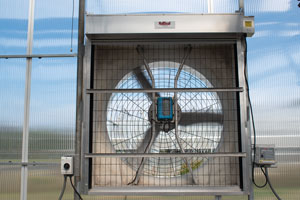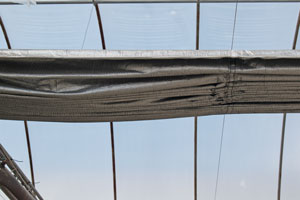11/1/2021
Getting Ready for Winter
Bill Swanekamp
With energy prices being so low over the past 10 years maybe we’ve become a little complacent about energy conservation. That’s about to change.
Since May of 2021, energy prices for natural gas have gone up by 50%. That’s a dramatic increase. It’s possible that we’ll see those prices trend downward over the next few months, but if they don’t then we want to be prepared to reduce our energy usage.
I’m going to talk about five things we’re using (and you also can use) to lower your energy costs.
 Replacement of the north wall of the greenhouse: Before acrylics and rigid poly walls were used, we built the outer north wall of the greenhouse out of treated wood. That wood lasted about 40 years, but it’s now falling apart and has many gaping holes. It was time to replace it with a rigid material like Polygal. We chose to install a triple wall material that helps with heat loss. We anticipate saving a considerable amount on our heating bill with this addition. It will reduce air infiltration dramatically.
Replacement of the north wall of the greenhouse: Before acrylics and rigid poly walls were used, we built the outer north wall of the greenhouse out of treated wood. That wood lasted about 40 years, but it’s now falling apart and has many gaping holes. It was time to replace it with a rigid material like Polygal. We chose to install a triple wall material that helps with heat loss. We anticipate saving a considerable amount on our heating bill with this addition. It will reduce air infiltration dramatically.
 Installation of new energy efficient fans: We have fans in our facility that are over 50 years old. Fifty years ago, they were considered top of the line, but today they cannot even cross the line. In fact, many of them were about to fall apart from rust. The new fans we installed this summer are high-efficiency fans that move about 40% more air per fan and use about 40% less energy per cu. ft. of air moved than the old ones. This means we could replace old fans with about 40% fewer fans than we had in the past. This also means we’ll use less electricity when they’re running. These fans get a lot of their efficiency from the fact that they have direct drive motors with frequency drives—there’s no fan belt to maintain or replace. Yes, it came at a premium, but we figure a seven-year payback.
Installation of new energy efficient fans: We have fans in our facility that are over 50 years old. Fifty years ago, they were considered top of the line, but today they cannot even cross the line. In fact, many of them were about to fall apart from rust. The new fans we installed this summer are high-efficiency fans that move about 40% more air per fan and use about 40% less energy per cu. ft. of air moved than the old ones. This means we could replace old fans with about 40% fewer fans than we had in the past. This also means we’ll use less electricity when they’re running. These fans get a lot of their efficiency from the fact that they have direct drive motors with frequency drives—there’s no fan belt to maintain or replace. Yes, it came at a premium, but we figure a seven-year payback.
 Installation of Roll Seal louvers on the fans: The typical fan in our industry comes with louvers that open and close when the fan turns on or off. The Roll Seal is a vinyl material that mechanically rolls up and down as the fan turns on and off. It’s also sealed along the edges of the device so there’s no cold air infiltration via convection or simply cold air blowing into the greenhouse. This is no minor matter. With the old-style louvers on the fans, it was impossible to keep the air temperature the same, within 20 feet of the north wall, as the rest of the greenhouse. Due to the sealing along the edges of the Roll Seal design this problem is eliminated. We anticipate we’ll save about 10% on our heating bill with the Roll Seals.
Installation of Roll Seal louvers on the fans: The typical fan in our industry comes with louvers that open and close when the fan turns on or off. The Roll Seal is a vinyl material that mechanically rolls up and down as the fan turns on and off. It’s also sealed along the edges of the device so there’s no cold air infiltration via convection or simply cold air blowing into the greenhouse. This is no minor matter. With the old-style louvers on the fans, it was impossible to keep the air temperature the same, within 20 feet of the north wall, as the rest of the greenhouse. Due to the sealing along the edges of the Roll Seal design this problem is eliminated. We anticipate we’ll save about 10% on our heating bill with the Roll Seals.
 Installation of new heat curtains: Starting last year we began replacing all of the heat curtains in our facility. So far, we’ve replaced 8 acres of heat curtains and plan to replace 12 acres more in 2021 and 2022. Most of the old curtains are over 20 years old and are showing their wear. We’re replacing them with material from LS that’s considered 100% shade with the highest heat retention value. We made the decision to use 100% shade material rather than a lower shading capacity because we want to maximize our ability to save on energy.
Installation of new heat curtains: Starting last year we began replacing all of the heat curtains in our facility. So far, we’ve replaced 8 acres of heat curtains and plan to replace 12 acres more in 2021 and 2022. Most of the old curtains are over 20 years old and are showing their wear. We’re replacing them with material from LS that’s considered 100% shade with the highest heat retention value. We made the decision to use 100% shade material rather than a lower shading capacity because we want to maximize our ability to save on energy.
You might be asking, how do the plants grow under such heavy shade? Well, we’ve learned that it’s only during the late spring and summer months that shading is needed. So, during the summer, we allow the curtains to be open 100%, but as the temperature rises, we start to close the curtain. Usually by noon the curtains are at about 75% to 80% closed. This means from sunrise to noon the plants have received a considerable amount of light and can continue to grow well without the stress of the high summer light levels and high temperatures. Then around 5:00 p.m. we start to open the curtains again and more light gets to the plants. We’ve used this method for over 30 years with good results.
Clean Energy Program: To help us improve our facility and reduce our energy footprint, we’ve applied for the Clean Energy Program. It’s designed to reward companies that spend capital to reduce their energy usage. Although we haven’t received our final numbers yet, we anticipate a rebate of up to $200,000 with this program.
Although, there’s still much work to do, we look forward to reaping the benefits of installing the balance of these energy-saving techniques and maybe keeping some money in our pockets as we get ready for winter. GT
Bill Swanekamp is president of Kube-Pak Corp., Allentown, New Jersey.